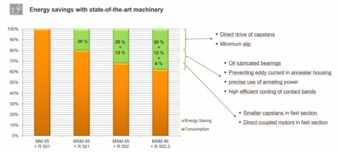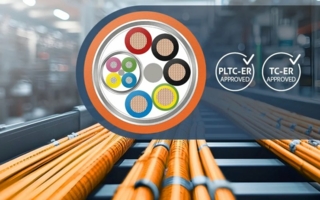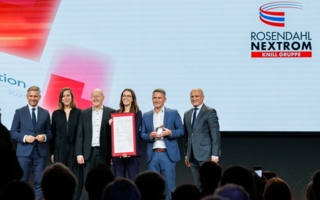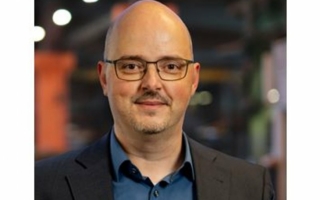10/03/2023 – Exemplary: Niehoff’s rod breakdown (RBD) lines
Investing in new machines pays off
Does it really pay off to invest in new wire and cable machines when existing ones, which are written off, are still working perfectly? This question should always be of interest for wire and cable manufacturers.
Indeed, such investments are worthwhile when new machines that represent the latest state-of-the-art technology help users save operating costs. Maschinenfabrik Niehoff, a manufacturer of machinery for drawing and further processing of wires made of non-ferrous metals, can prove this by means of rod breakdown (RBD) lines. Significant cost savings result from a reduced need for drive energy and shorter production times.
Reduced need for drive energy
Niehoff introduced the RBD machine type “M 85” to the market in 1962 and, building on this, has since then continuously further developed the RBD technology. In 1998, Niehoff launched the RBD machine type “MSM 85” with electronically controlled individual drives, and in 2013 the RBD machine type “MSM 86”. This machine has then been the subject of continuous further development until today.
The technical progress concerning these machines and the drawing lines built with them is shown by the fact that for operation less and less drive energy has been needed – and thus saved.
When considering an RBD line consisting of a drawing machine type “MM 85”, the two-wire version of the M 85, and a continuous resistance annealer type “R 501” as a basis for comparison, the RBD line type “MSM 85 + R 501” needs around 20% less drive energy. This saving is made possible above all by the electronically controlled direct drive of the drawing capstans and the resulting slip minimization.
A further 12% reduction in energy consumption results from combining an “MSM 85” with an annealer type “R 502”. This annealer is designed to use the annealing energy more efficiently than its predecessor and eddy currents in the annealing housing are avoided.
The latest result of the technical development is the drawing line type “MSM 86 + R 502.2“. It enables an additional 6% of drive energy to be saved. This is made possible by using smaller drawing capstans and directly coupled drive motors in the fast part of the machine.
Niehoff received a supplier award from the cable manufacturer Nexans in 2022 for a line of this type. In close cooperation, technicians from Niehoff and Nexans succeeded to reduce significantly the drive energy of the entire line during the complete process as well as the production times.
Considerable energy cost savings
For drawing, annealing and spooling wire with a diameter of 8.00mm to a final diameter of 2.05mm, a line type “M 85 + R 500 + S 630 D” requires about 210kWh/t. A line type “MSM 86 + R 502.2” needs only 129kWh/t, which means 38% less. Considering an annual production of 48,000t and an industrial electricity price of 0.27€/kWh*, the saved amount of energy of around 80kWh/t is equivalent to annual cost savings of far more than 1 million euro!
38% energy savings ≈ 80kWh/t x 48,000t/a x 0,27* €/kWh = 1,036,800€/a
Shorter production times
As modern RBD lines can be reliably operated at higher production speeds, their application reduces production times for a given production quantity. For example, an RBD lines line consisting of a drawing machine type “MSM 86”, an annealer type “R 502” and two automatic down coilers type “WF 801” can draw two copper wires to a final diameter of 2.60mm at a speed of 24m/s, corresponding to a production output of 8t/h. Compared with older lines, whose production speed is limited to 21m/s, the application of a drawing line type “MSM 86 + R 502” reduces production times by 12.5%, which corresponds to a considerable cost-saving potential. For example, with an annual production time of 7,000hours and an hourly production line rate of €180, this savings potential amounts to €157,500 per year:
7,000h/a x 12.5% = 875h/a;
875h/a x 180€/h = 157,500€/a
What are the next steps?
The cost saving potentials mentioned above indicate that it is worthwhile for wire and cable manufacturers to invest in new machines, even if the old ones “still do”. And Niehoff is continuing to make cost-saving opportunities accessible. Niehoff is currently working on a new continuous annealer whose special feature is that less input energy is required for recrystallization of the wires passing through. At the “wire 2024” trade fair, Niehoff will present the next development stage, the RBD line type “MSM 88 + R 503”.
The author Konrad Dengler is freelance journalist from Großenseebach, Germany.
* Industrial electricity price (incl. electricity tax) in Germany in 2022 according to statistics portal Statista
https://de.statista.com/statistik/daten/studie/252029/umfrage/industriestrompreise-inkl-stromsteuer-in-deutschland/
Maschinenfabrik Niehoff GmbH+Co. KG
Walter-Niehoff-Strasse 2, 91126 Schwabach, Germany
Contact person is Norbert Meyer
Tel.: +49 9122 977-291
n.meyer@niehoff.de
www.niehoff.de





